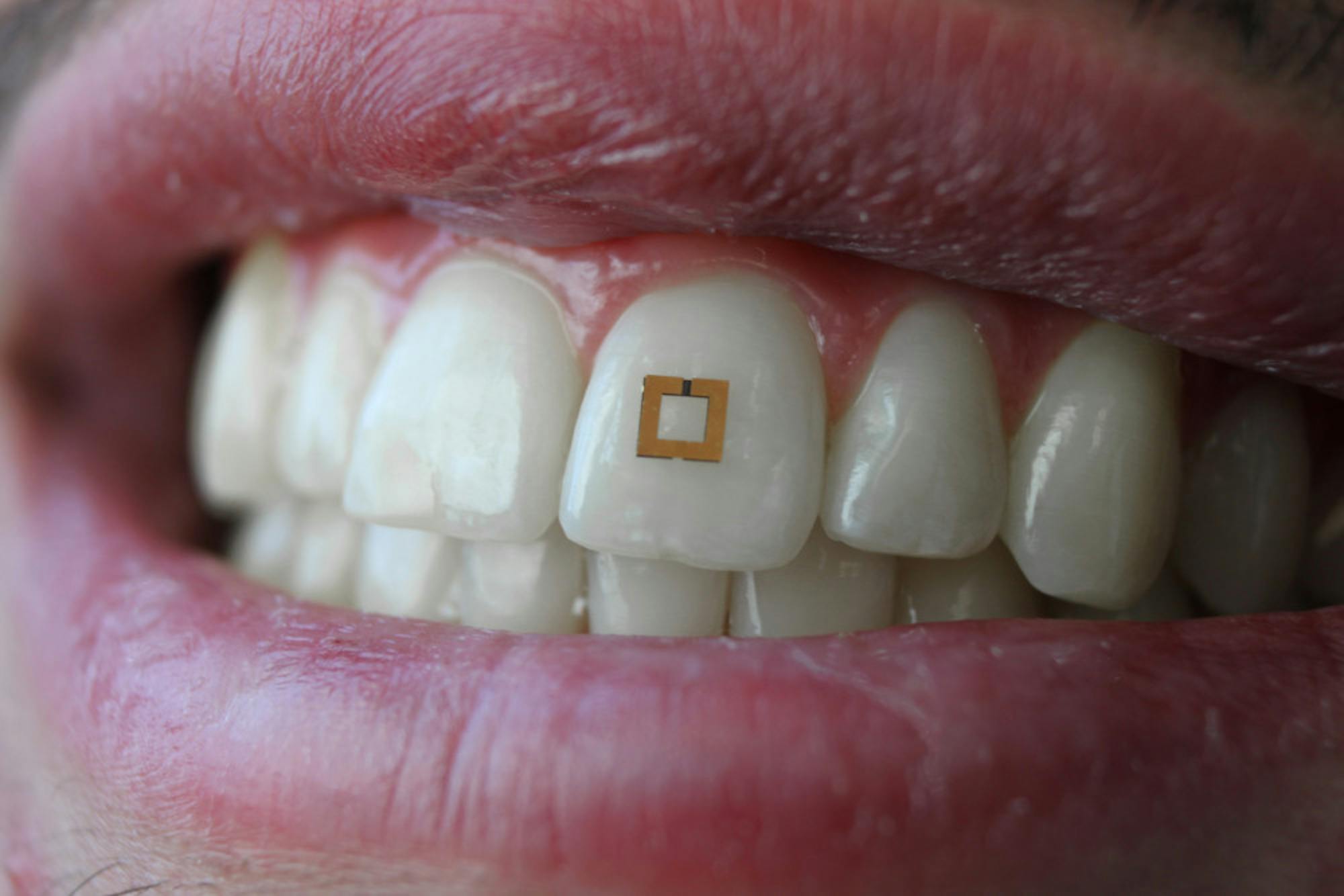Research done at the School of Engineering on a new, miniaturized diet-tracking tooth-mounted sensor has recently garnered significant media attention. On March 23, a team from the Department of Biomedical Engineering, led by Frank C. Doble Professor of Engineering Fiorenzo Omenetto, published their research in the journal Advanced Materials about a tiny sensor -- two millimeters by two millimeters -- that is placed on a tooth and can track a person's nutritional intake.
The other authors are Peter Tseng, former postdoctoral associate in Omenetto’s lab;David Kaplan, Stern Family professor of engineering and chair of the biomedical engineering department;Bradley Napier, a third-year Ph.D. student in biomedical engineering; and senior and electrical engineering major Logan Garbarini.
“How the sensor works is you have two pieces of metal film and in between there's a silk [inter-layer], and that inter-layer is sensitive,” Garbarini said.
According to Omenetto, on either side of the silk inter-layer, there are two antennae. Based on the sensitivity of the inter-layer, the antennae will be able to detect what is happening. For example, depending on the pH level inside the pouch, the antennae will observe the inter-layer either swelling up or contracting.
As Garbarini described, the sensor uses a transduction mechanism to relay the information that it detects.
“We have a transduction mechanism that is based on the thickness of the film, and when the thickness of the film changes due to swelling, due to ethanol or pH or whatever, then you have this great electromagnetic frequency change,” he said.
Omenetto explained that depending on the contents or pH levels that the sensor detects, it can identify what foods are being consumed. While the device can currently detect the consumption of numerous foods, Omenetto noted that expanding the list of detectable foods is one of the main areas of improvement.
“We need to build sensitivity and specificity,” he said.
The miniature size of this device makes it unique. Garbarini mentioned some other in-mouth devices but explained that their size made them impractical.
“There’s been discussion about putting some sensors in mouth guards for football players, but that’s pretty bulky; you can’t wear that day-to-day,” Garbarini said. “So there’s a lot left to be desired in terms of the technology [and] where the technology goes next. So the tricky part is, how do you get something so small that’s not intrusive?”
The size is something that Garbarini believes they have accomplished.
“The sensor that we developed is really thin, tens of microns thin, so that is something that is really small and can be left on the tooth,” he said.
Jianmin Qu, dean of the School of Engineering, also noted a few other significant breakthroughs.
“The sensor works using a miniature antenna, hidden behind an outer layer that responds to different nutrients or chemicals, such as glucose, salt and alcohol. More importantly, the device is a multilayered structure where each layer responds to a different type of nutrients or chemicals, thus enabling the sensing of different foods,” he said in an email to the Daily.
Omenetto attributed the uniqueness of the device to the usage of silk.
“This is something that comes with the territory of buying materials in silk, and the silk devices, and the things we do,” he said.
In his career, Omenetto has specialized in working with silk. In 2011, he gave a TED talk on the numerous groundbreaking applications of silk. His lab at Tufts is named the SilkLab for its focus on silk research.
The ideas behind this device were born when Omenetto first began working with the material.
“When I started working with silk, I looked at silk as a material platform for unusual devices, meaning flexible electronics, conformal electronics, implantable electronics, implantable optics, electronics that you can eat, optics that you can eat and these types of things,” Omenetto said. “And it sort of evolved a little bit; the platform went through its various phases.”
After working with silk for some time, Omenetto first began exploring the option of silk used in mouth sensors with a colleague at Princeton University in 2012.
“I always thought that it was a good idea because the oral cavity has a ton of markers,” he said.
While Omenetto and his team have been working on this device for years, they only began experimenting with a version of the device about a year and a half ago. According to Garbarini, the process included a lot of trial and error, as well as several frustrating false starts.
“There [were] false starts, [where] you start seeing some data and say, 'Oh, this looks good, I'm going to run some more tests,' and then of course, soon enough ... you find out that doesn't work,” Garbarini said. “So there was a lot of back and forth, and false starts, and kind of getting somewhere and then realizing you had to take four steps back and go in a different direction.”
“That's probably the hardest part from a mental perspective. It's not a linear path. You go down one path and it's a dead end. You have to go all the way back and start down another path, and that's sometimes [also] a dead end,” he said.
At the moment, it is unclear where this device will go next. While it seems likely that the device will be used for commercial purposes in the future, Garbarini and Omenetto agreed that there are still many intermediate steps to be accomplished.
“I think there's a lot of chance to put this in the hands of dental researchers, or someone researching somewhere that's not immediately commercial. [There's a chance] to start off with getting it somewhere in another research lab that is researching an actual clinical issue, [such as] dry-mouth, tooth decay, diabetes, or something like that,” Garbarini said.
Omenetto believes that there are many possible applications for this device.
“I think that the ways it can help really depend on a bunch of things. It depends on a clinical need, it depends on an economical need, it could be a lifestyle application, it could be a diagnostic application [or] it could be a compliance application,” Omenetto said. “If you have someone who is recovering from surgery and needs to go through a drug regimen, [the device] helps [to] keep somebody apprised of the rate of drug intake, for example.”
He added that their research is unprecedented in the world of wearable technology.
“The material formats are, I think, unique,” Omenetto said. “The fact that you can start making these wearable pouches, and these little [devices] embedded by polymer layers, and these real tiny, tiny formats, is kind of neat.”
However, Omenetto explained that he is currently only focused on improving the device.
“As far as I'm concerned, I think that we want to make the material smarter and smarter. So we really want to address sensitivity and specificity,” he said.
While the device has received considerable praise, Omenetto understands that the device is far from its potential.
“The device is still a prototype. It's still a very coarse detection technique. So it may have some utility, but I think that its utility needs to still advance in order to do what the people have written the device may do. But I think the direction is really into making the material more sophisticated and still compact, and very manageable,” he said.
Professor Fiorenzo Omenetto leads team behind innovative, tiny tooth-mounted diet tracker

Tufts researchers and engineers have recently developed a tooth-mounted sensor that can track one's diet.





